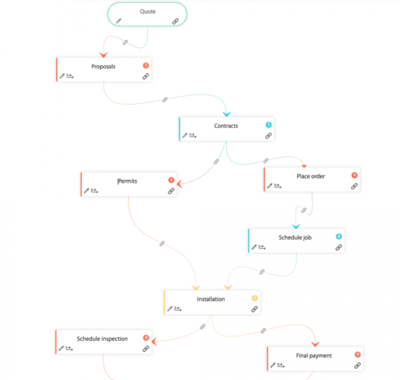Workflow
What is Workflow?
Workflow refers to the sequence of processes through which a piece of work passes from initiation to completion. In a business context, a workflow is the systematic organization of tasks, activities, responsibilities, and data required to complete a process efficiently and effectively. Workflows are designed to streamline and standardize repetitive processes, ensuring consistency and optimizing resource usage.
Key Components of Workflow
- Tasks: The individual actions or steps that need to be completed within a workflow.
- Actors: The entities (people or systems) responsible for performing the tasks.
- Sequence of Actions: The order in which tasks must be performed, often defined by rules or conditions that dictate the workflow's progression.
- Data or Artifacts: The information and documents that are used and produced through the workflow.
- Outcomes: The expected results or products of completing the workflow.
Purpose and Role of Workflow
- Efficiency: By defining clear paths for tasks and reducing redundant activities, workflows help improve the efficiency of business processes.
- Accountability: Workflows assign specific tasks to individuals or teams, making it easier to track responsibility and accountability.
- Scalability: Standardized workflows can be scaled up or modified with relative ease, accommodating business growth or changes in procedure.
- Quality Control: Consistent processes and predefined steps in a workflow help maintain the quality of outputs by reducing the likelihood of errors.
Importance of Workflow
- Process Optimization: Effective workflows are crucial for optimizing business processes, enhancing productivity, and reducing costs.
- Transparency: Workflows provide a transparent view of the status of various tasks, helping management monitor progress and identify bottlenecks.
- Collaboration Enhancement: Clearly defined workflows facilitate better collaboration among team members by delineating roles and responsibilities.
Types of Workflow
- Sequential Workflow: Tasks are performed one after another in a specific order. Each step depends on the completion of the previous one.
- Parallel Workflow: Allows multiple tasks to be performed simultaneously, speeding up the process and improving efficiency.
- Conditional Workflow: Includes decision points that dictate the flow based on certain conditions, allowing for dynamic responses to different situations.
Workflow Automation
Workflow automation involves the use of software tools to automatically route tasks between participants, enforce rules, and ensure that all parts of the workflow are completed correctly. Automation is particularly beneficial in:
- Reducing Manual Tasks: Automating repetitive tasks frees up personnel to focus on more value-added activities.
- Decreasing Process Times: Automated workflows can operate continuously and more quickly than manual processes.
- Increasing Reliability: Automation reduces human error and ensures that tasks are performed consistently.
Examples of Workflow Applications
- Customer Service: Managing customer inquiries through a ticketing system that routes requests, escalates issues, and tracks resolutions.
- Human Resources: Onboarding new employees with a workflow that includes steps for paperwork, training, equipment allocation, and account setup.
- Healthcare: Patient management systems where workflows manage everything from patient registration to treatment and discharge processes.
Challenges in Workflow Management
- Complexity: Designing workflows that are both efficient and flexible can be complex, especially in environments with many interdependent tasks.
- Resistance to Change: Implementing new workflows can meet resistance from staff accustomed to existing processes.
- Integration: Integrating new workflow systems with existing IT infrastructure requires careful planning and execution.
Conclusion
Workflow management is a critical aspect of organizational efficiency, providing structured mechanisms through which work is conducted. By effectively designing, implementing, and managing workflows, organizations can achieve higher productivity, better quality control, and improved operational efficiency. With the advent of workflow automation technologies, the potential to enhance these benefits has increased significantly, allowing organizations to achieve more with less.
See Also
- Business Process Management (BPM): Discussing the discipline of managing and optimizing a company's business processes from end to end.
- Process Automation: Covering technologies and methods used to automate repetitive tasks within a workflow to increase efficiency and reduce human error.
- Project Management: Exploring how workflow management is crucial within the context of planning, organizing, and managing resources to achieve specific project goals.
- Lean Manufacturing: Discussing the application of lean principles to workflow optimization in manufacturing environments to eliminate waste and improve productivity.
- Systems Engineering: Exploring how workflow concepts are applied in the development and integration of complex systems.
- Software Development Life Cycle (SDLC): Covering how workflows are structured within software development projects to ensure systematic progress through phases such as planning, design, building, testing, and deployment.
- Change Management: Discussing how managing workflow effectively is key to successful change management practices in organizations.
- Quality Control (QC): Exploring how workflows incorporate quality control steps to maintain standards and ensure outputs meet required specifications.
- Document Management (DM) Systems: Covering how these systems manage the flow of documents through an organization’s workflow and ensure compliance with policies and regulations.
- Customer Relationship Management (CRM): Discussing how workflows within CRM systems help manage customer interactions and business processes to improve customer service and satisfaction.

